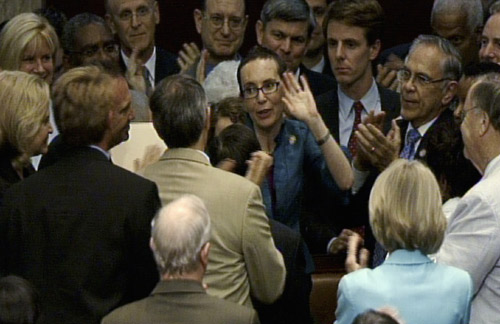US debt deal only 1st step on tough austerity journey
 0 Comment(s)
0 Comment(s) Print
Print E-mail
Xinhua, August 2, 2011
E-mail
Xinhua, August 2, 2011
The last-ditch bipartisan debt ceiling plan emerging Sunday has passed the U.S. House of Representatives, which is a relief to global markets but is also a prelude to a long-term tough fiscal consolidation task facing the world's largest economy.
 |
|
US Representative Gabrielle Giffords (R-TX) (C) waves to colleagues on the floor of the House of Representatives, moments after the House voted to raise the US borrowing limit, in Washington in this still image taken from video August 1, 2011. [China Daily via agencies] |
Last-minute deal
As President Barack Obama took the podium of the White House briefing room Sunday night to announce the last-minute deal ahead of the Tuesday deadline, he was ending a perilous and widely-scrutinized stalemate.
The deal calls for slashing the country's deficit by over 2 trillion U.S. dollars over the next decade, tasking a new congressional bipartisan committee to explore new ways for deficit reduction, and of course raising the U.S. borrowing limit through 2013, which is a bottom line in the debt limit negotiations for the White House.
Wars in Afghanistan and Iraq, the former administration's tax cuts, anti-recession stimulus packages under Obama, and ballooning Medicare expenses in an aging society all contributed in a major way to the spiking U.S. national debt.
As the debt levels soared, the federal government's borrowing limit, currently at 14.29 trillion dollars, was reached on May 16. The Treasury said that it would run out of cash to pay its bills unless Congress agreed to raise the limit by Aug. 2.
After a prolonged bipartisan battle over how to raise the debt limit, the two sides finally reached a last-minute deal.
With the White House-backed bill already passing the Republican-controlled, the Democratic-dominated Senate is widely expected to nod it on Tuesday.
Meeting GOP standards
U.S. House Speaker and No. 1 Republican John Boehner, a key player in the intense debt ceiling talks, said Monday the bipartisan deal emerging Sunday night met Republican standards of no new tax increases and spending cuts bigger than the size of the debt limit increase.
If it passes the Senate as expected, the bill would create a bipartisan and two-chamber congressional committee to find new deficit reduction ways in line with the second tranche of debt limit increase by November. The White House said the panel will be tasked with finding a deficit of at least 1.5 trillion dollars to trim.
However, some liberal Democrats and economists countered that this package is not balanced, as there is no guaranteed new revenue from the deal.
Although some White House officials insisted that the new powerful committee could serve as a vehicle for raking in revenues through tax code reforms, many analysts said that half of the 12 committee members are Republicans and therefore unlikely to give the green light to any new revenue or a tax hike.





